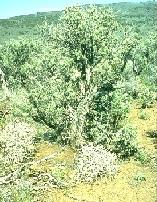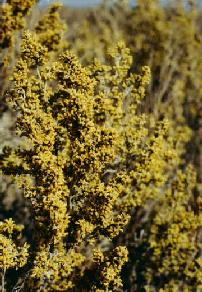
Copyright © 1995 Brother Eric Vogel, St. Mary's College

Copyright © 1995 Brother Eric Vogel, St. Mary's College
Basin Big Sagebrush
Artemisia Tridentata Nutt.
Common, much branched grey-green shrub, 2 to 10 feet tall, found throughout the Intermountain West. Leaves are aromatic, evergreen, and somewhat wedge shaped. Buds develop in September and open in early to mid-October. They produce rayless flowers from which the stamens protrude bearing yellow pollen. There are many flowers on each top branch of each shrub, the top appears to have turned yellow--and often bends under the weight of the flowers. Widespread throughout the Intermountain area.
Food Use:
Leaves are cooked. The subspecies A. tridentata vaseyana has
a pleasant mint-like aroma whilst some other subspecies are very bitter and
pungent. The leaves are used as a condiment and to make a tea. The seeds my be
used raw or cooked. Oily. It can be roasted then ground into a powder
and mixed with water or eaten raw. The seed is very small and
fiddly to use.
Medicine:
Sage brush was widely employed by many native North American
Indian tribes who used it to treat a wide range of disorders. It is little used
in modern herbalism, though it certainly merits further investigation. The plant
is ant rheumatic, antiseptic, digestive, disinfectant, febrifuge, ophthalmic,
poultice and sedative. A decoction of the leaves is used in the treatment of
digestive disorders and sore throats. An infusion of the fresh or dried leaves
is used to treat pneumonia, bad colds with coughing and bronchitis. It is used
both internally and externally in the treatment of rheumatism. The crushed plant
is used as a liniment on cuts, sores etc whilst a decoction of the leaves is
used as an antiseptic wash for cuts, wounds and sores. A poultice of the steeped
leaves is applied to sore eyes. The plant is burnt in the house in order to
disinfect it.
Other Uses:
The fibrous bark is used for weaving mats, baskets, cloth etc., or as a stuffing
material in pillows etc and as an insulation in shoes to keep the feet warm. A fiber
obtained from the inner bark is used for making paper. The fibers are about 1.3mm
long. The stems are harvested in late summer, the
leaves removed and the stems steamed until the fiber can be stripped off. The fiber
is then cooked for two hours with lye before being ball milled for 4
hours. The resulting paper is a light tan/gold color. (PFAF)
Problems:
The plant is very aromatic, especially after rain. The pollen
of this species is one of the main causes of hay fever in N. America.
Value for Wildlife:
Considerable quantities of big sagebrush are eaten by sage grouse, mule deer,
and pronghorn. For mule deer in Utah, basin big sagebrush is the least preferred
of all subspecies of big sagebrush. In some instances, mule deer preference of
basin big sagebrush varies greatly by local population. Pygmy rabbits
forage extensively on big sagebrush Pygmy rabbits feed on basin big
sagebrush but show preference for certain accessions.
Basin big sagebrush generally is not preferred by sage grouse; however,
the birds do exhibit preferences for certain individual plants. Sage grouse
readily feed on basin big sagebrush where mountain and Wyoming big sagebrush are
absent. Basin big sagebrush may serve as emergency food during severe
winter weather, but it is not usually sought out by wildlife.
Planting:
Cuttings of half-ripe wood should occur in
July/August. Very slow to root. The young growth in spring, even on mature
plants, is frost-tender and so it is best to grow the plants in a position
sheltered from the early morning. Requires a sunny position and a
well-drained soil that is not too rich[ and is lime free. There are a number of
sub-species growing in different habitats from deep fertile soils to poor
shallow ones. Plants are longer lived, more hardy and more aromatic when they
are grown in a poor dry soil. Established plants are very drought tolerant.
.
© Jean H. Zach